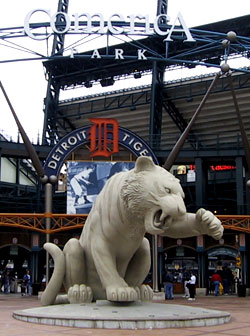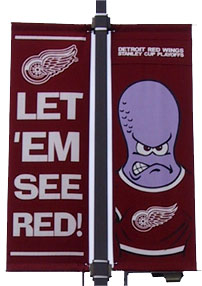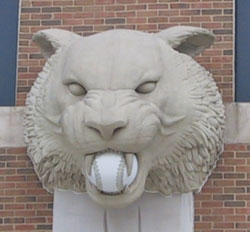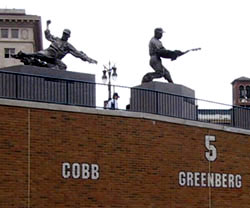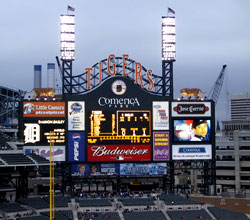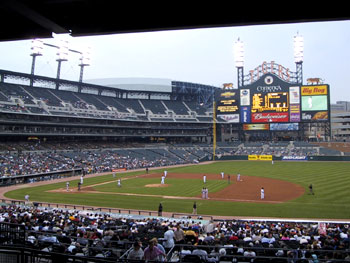 |
 |
|
|
|
|
|
|
|
|
|
|
|
|
|
|
|
|
|
|
|
|
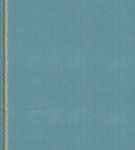 |
|
Sox On The Road: Detroit
After taking road trips from Atlanta by car last year for Red Sox road games in Tampa, Cleveland, and New York, my 2002 Sox on the Road series began in Detroit, Michigan by air, courtesy of having a best friend working for the airlines and being named his travel companion. As a result, I get unlimited discounted airfare and the round trip between Atlanta and Detroit was a mere $57, all taxes included. Not that I haven’t done my share of driving this year; I had already taken a cross country trip by car to California and many points in between by the time my plane landed at Detroit Metropolitan Airport, located 18 miles west of downtown Detroit, on the fourth of June.
Detroit is known as the home to the automobile, and is also the site of the nation’s first stretch of paved road and traffic light. Unfortunately, the public transportation system lags far behind. Even the visitdetroit.com website exclaims, “Detroit does not have a comprehensive public transportation system. The best way to see the region is by car.” So upon arrival I had the option of paying $30-40 for cab fare to downtown or renting a car, but I opted for the SMART bus and its $1.50 fare. Despite the financial savings, the bus took an 1:15 minutes to reach downtown and took me through much of the decrepit areas of Detroit and the outside metropolitan area. The ride from the airport, which is “out in the sticks,” doesn’t give a particularly flattering first impression of Detroit. When the Red Sox hit the Motor City for their four game series June 3 – 6 I was one of the few souls who had traveled to Detroit during this particular week with the explicit purpose of watching baseball. As it happened, I invaded Detroit during the Stanley Cup finals, and the Red Wings’ hold on Hockeytown was in full force. While the Fall Classic takes place at October’s end, pro hockey’s signature Series takes center stage in the muggy summer month of June. And befitting of the off-kilter “Christmas in July” theme, Hockeytown shines brightest in June. All around Detroit were symbols of the Red Wings. The official motto emblazoned on street post banners was “LET ‘EM SEE RED!” The Hockeytown Café, located across the street from Comerica Park, showed the game on an outdoor, Times Square-like video board. Numerous cars had Red Wing car flags, and there was even a Hockeytown Car Wash located downtown.
Even the Spirit of Detroit statue adorned a huge Red Wings jersey. As I prepared to take a picture of it a reporter from the local NBC station interviewed me on camera over the question, “What do you think a Red Wing is?” I noted that there might be some kind of synergy between the Red Wing shoe company, which has a similar wheeled-wing logo. Meanwhile, there was a baseball being played on the other side of town at Comerica Park. Not that the Michael Illitch-owned Red Wings didn’t receive any attention at the Tigers’ (also owned by Illitch) venue. During Tuesday’s game, large burst of screams and applause (signifying Detroit goals) twice interrupted what appeared to be lulls in the baseball game, where there were far more Red Wings jerseys being worn in the stands than those of the Tigers. After the baseball game ended, the remainder of the hockey game was shown on the Comerica Park big screen scoreboard. As for the ballpark, Comerica Park is another in the line of the picturesque throwback era ballparks situated in the heart of downtown. Comerica’s all brick exterior is circled by stone tiger heads with a baseball between clinched teeth. The two main entrance gates, both down the right field line, are guarded by huge tigers with menacing scowls.
Although not as omnipresent on the inside, Comerica Park does have brick in the one place it is most likely to be noticed: the area extending from either side of the tree-lined hitter’s backdrop. When watching the game on TV, the brick dominates the backdrop and takes up large portions of what’s visible on the screen. But when you actually watch a game at Comerica in person, you hardly notice it.
The brick wall serves as a Tigers Wall of Fame, with last names of six Tigers immortalized on the wall in left-center. On the above concourse, there are six 13-foot sculptures of former Tiger greats Al Kaline, Hal Newhouser, Charlie Gehringer, Hank Greenberg, Ty Cobb, and Willie Horton. Aside from Cobb, who played before there were numbers, the other five have their retired number etched in the brick directly below their statues. The last name of Tiger legends that played before numbers were worn adorn the right-center field stretch of brick. A notable exception is the name Harwell, the famed Tiger broadcaster who is retiring when the 2002 season commences after 55 years in the booth. The outfield concourse that stretches from left to right field is also a good place to watch the game for a couple of innings. One surprising thing about Comerica Park games at night are the large flocks of seagulls that frolic in the outfield grass during the game. Comerica Park has many other distinctive features, although not all of them are original. The first thing you notice when you look out towards the playing field is the huge scoreboard in left field. At ten stories and 147 feet high by 202 feet wide, it is the largest in baseball. The idea was borrowed from Cleveland’s Jacobs Field jumbotron, which was the biggest until Detroit copied the feature and made theirs slightly bigger.
Sitting atop the scoreboard, on either side, are a pair of orange and black tigers, whose eyes flicker green when a Tiger hits a home run and during the classic Survivor song “Eye of the Tiger.” The light towers are in the form of toothbrushes, just like those at Jacobs Field. While Tiger Stadium’s distinctive bank of lights can still be spotted from most places in Detroit, Comerica Park is only visible from a short distance. The field is dug below street level, so the ballpark doesn’t appear to be very large as you approach it from the outside. Directly above the hitter’s backdrop in center field is the General Motors Fountain, which remains dormant during the game unless a Tiger homers. It is used before and after games when it spurts water streams that are choreographed to music. Immediately after each game I attended, all won by Boston, the water bursts would stream and sway to the beat of Celine Dion’s “Misled.” I’m not sure what music they play when the Tigers win, but all of the songs to which the water danced after Tiger losses were Celine Dion hits. The fountain is also the centerpiece of the fireworks show that occurs after every Tigers Friday night home game. Spraying water up to 150 feet high, the fountain is programmed to changing lights as well as music. If you sit in the upper deck, you can easily see the cylinder shaped headquarters of General Motors directly behind the fountain that it sponsors. When I first heard the name Comerica Park I had no idea what Comerica was. Actually a bank, it sounded circus-like to me and inside the stadium you’ll find a pair of carnival rides to follow up on that notion. There is a merry-go-round with 30 hand-painted tigers in the middle of the circular food court and for further amusement, there is a 50-foot high Italian-made ferris wheel with 12 cars shaped like baseballs. The cost to ride each is $2, except on Sunday when kids 14 and under get to ride for free. As for the ballpark fare, a bag of Cracker Jack was $2.75, a cup of ice cream $2.50. There were a number of Little Caeser’s pizza stands throughout the ballpark, no surprise since the team’s owner made his millions by founding the chain in 1959. Beer was $6.25 and the cola of choice was Pepsi. An unadvertised secret that I found out about was that if you buy a $12 upper level ticket or an $8 bleacher seat, you receive a free coupon for one small soda, and choice of a hot dog or small slice of pizza. The coupon is printed out like a Ticket Master ticket and is good throughout the entire season, in case you ate before you arrived. As all new ballparks do, Comerica had a restaurant located on its premises, albeit a McDonald’s, which is open to the general public before games, but jacks up its prices and caters to fans only during the game. You can, however, actually watch the game without having to pay admission if there is a sparse crowd. You can easily see the field and most of the action from the street in right-center. Only if there are lots of fans in attendance walking about the concourse will your sight lights be obstructed, which was not the case at the first two games I saw. The ballpark is framed by the downtown Detroit skyline from center to right field. A building beyond the right field foul pole has a large sea-themed mural with dolphins and whales as the prominent feature. Directly behind the third base grandstand, the new home of the Detroit Lions, Ford Field, is in its final stages of construction. The domed stadium will be completed before summer is over - as of my visit the roof was half finished - and has already secured the 2005 Super Bowl for the city. While nobody will miss the Lions’ former home, the Pontiac Silverdome in the nearby suburbs, baseball fans still wax nostalgic about Comerica Park’s predecessor, Tiger Stadium, which still stands at the corner of Michigan and Trumbull. The two ballparks are a short walk from each other, separated by only 1.37 miles, but Comerica has the dubious distinction of replacing the baseball cathedral and registered Michigan historic site that hosted Tiger baseball for 103 years, 88 of them as the ballpark that officially changed its name to Tiger Stadium in 1961.
Although I never saw a game at Tiger Stadium, I made the short pilgrimage by foot to see “the grand Old Lady at the corner.” Unfortunately, Tiger Stadium has been left to decay since the Tigers played their last game there on September 27, 1999. Owned by the city, but maintained by the Tigers, the ballpark is not open to the public and consequentially there are no tours. Walking around the outside, I was appalled at the weeds and grass growing through the sidewalk down Cochrane Avenue. The ads visible inside the stadium have remained unchanged for three years and weeds are visible inside the Tiger Plaza, where the paint from the old building has begun to peel. About half the lights on the neon Tiger Stadium sign at the main gate remain lit, until they burn out like the others. Apparently, a women’s fast pitch softball team has tried to rent out the facility for use, but the asking price is so high that it remains dormant, with the exception of a few Friday nights during the summer when fans can pay $1,300 to attend a Tiger fantasy camp, with the opportunity to play games at both the old and new home of the Tigers. Other than that, the stadium was used for the filming of the HBO movie “61,” which was directed by Billy Crystal. According to the Friends of Tiger Stadium website, the future looks bleak, as the city of Detroit is taking bids for demolishing Tiger Stadium. They also cite the fact that the city pays the team $400,000 a year just to mow the grass, which from what I was able to gather from Tiger employees and fans is all that is done to maintain the facility. About the only thing left down the brick paved portion of Michigan Avenue that runs parallel to Tiger Stadium is the souvenir store Sportsland, USA, which has an excellent selection of Tiger related memorabilia and posters and gear featuring old logos and players from other teams. It is open year round (Mon-Sat, 10-5) at 1444 Michigan Avenue, “a pop-fly east of Tiger Stadium.” What I can’t understand is why the city doesn’t just open up the stadium to the public and set a donation box outside. I would’ve gladly dropped a five-dollar bill in the tin for an opportunity to see one of the true vintage ballyards of baseball’s storied past. I know that there are plenty of volunteers who would maintain and upkeep the stadium free of charge. If you want to learn more, check out the Friends of Tiger Stadium website for further information, and links to articles about the future of Tiger Stadium. Unable to see the inside of Tiger Stadium, I did manage to see the final three games of the series at Comerica Park and all were Red Sox wins. Boston did drop the first game of the four game set when the Tigers rallied from a 6-4 deficit to win in extra innings, but I watched that game on TV back at home in Atlanta. Aside from the surprising loss in the opener started by Pedro Martinez, I noticed that the players and fans were bundled up, which I thought to be odd considering it was June and the temps were in the 90’s in much of the country. So on that note I packed a jacket for the journey, which would be needed. Tickets for Comerica Park range from $5-60. After arriving late for Tuesday’s game due to the public transit dilemma, I bought a ticket from someone on the street for $5. He said it had a face value of $20, although I only checked the date and time to safeguard against the possibility of buying a useless ticket. I should’ve checked the ticket more thoroughly, as there was no price printed it and the stub was actually attached with a piece of scotch tape. Comerica Park is one of many venues that use the new scanning technology, where your ticket is scanned and the stub is not torn. My ticket wouldn’t scan, but fortunately they didn’t seem to care and the ticket taker detached the reattached stub and let me in. Although my ticket was for the upper deck, I sat down the right field line before moving to the seventh row down the left field line, and the Red Sox beat the Tigers 10-5. On Wednesday I arrived early to watch batting practice, as Comerica Park opens its gates two hours before game time. This time I bought my ticket from the box office, a $5 skyline seat, but the first thing I noticed when I walked through the gates was the tarp covering the field because of threatening weather.
With BP cancelled I filled my time by watching Pedro Martinez throw a side session in the bullpen with Tony Cloninger looking on. After that, I walked around the Comerica Park concourse and read about the history of the Detroit Tigers, broken down on a decade-by-decade basis. When I had finished my history lesson I picked up a complimentary copy of the Detroit News, which prints a special baseball-only Comerica Park sports section. The paper was very thorough in its coverage of the series and had some very good feature pieces on both the Tigers and Red Sox. For the game I chose to sit in the fifth row of the upper deck, near home plate on the first base side. I think these were actually the best seats in the house, as I had a perfect view of the entire playing field plus an unobstructed panoramic view of downtown Detroit and Ford Field. The entire upper deck was so sparsely populated that none of the concessions were open, even directly behind home plate. As the temperatures began to drop into the 50’s, a steady rain began to fall as the Red Sox pounded the Tigers 11-0, aided by six shutout innings from Michigan native Derek Lowe. For the last inning, I moved down to the lower level and sat in the front row directly behind the Red Sox dugout. The final game of the series was a Thursday matinee. I showed up an 1:45 before game time, but all of the $5 and $8 seats were sold out, snatched up by large throngs of school children who apparently were not yet out for the summer. According to the ushers, the Tigers draw their largest crowds for afternoon games and the 21,992 was easily the largest of the series and the only one not inflated by numerous no-shows. The ushers in Detroit were very friendly and knowledgeable, and made my visit much more pleasurable. Most of them had worked at Tiger Stadium and had interesting stories to tell of that experience. While watching BP before the game I struck up a conversation with the usher in charge of the section directly behind home plate. He told it was fine to remain in that section when the game started, and after watching the rest of BP from the left field bleachers, I returned to the section twenty minutes before the first pitch. I sat in the fourteenth row, where I could watch the breaking ball break and hear the pop of the ball hitting the catcher’s mitt. Just before the game started, the advance scout for the Arizona Diamondbacks (Mike Patnik) showed up and sat next to me, although I thought he was just a businessman until I saw the name tag on his carry bag in the second inning. We talked a little bit and he was wearing his World Series ring, which he showed me up close. There were two other scouts sitting next to him, and an executive of the Tigers was sitting behind me. At one point I heard one of the scouts talking about former Tigers GM Randy Smith, who was fired in April. I found out that Smith had put his house in Detroit on the market and that he is looking to move to Arizona. The man with the Tigers was constantly on and off his cell phone. The amateur draft had just been completed the day before and the conversation turned to that subject. The Tigers guy commented that the Oakland A’s did not draft a high school player until the 18th round, and he said that if the Tigers had done the same thing he would have been “vilified in the local press.” In the meantime the Tigers were being vanquished on the field, as Rolondo Arrojo pitched four-hit shutout ball through seven innings. On a perfect day for baseball, and with as perfect a seat as a regular fan could hope far (without paying the price), I watched the Red Sox win for the third straight game. Aside from baseball, and the Red Wings, there isn’t a whole lot to do or see in Detroit. Prior to entering Detroit, about all I knew of Michigan’s largest city was that it was the murder capital of the world. I was actually mistaken, as Detroit is the most dangerous city in the US in terms of crime. The amount of murders (only 395 in 2001) has been surpassed by other cities since Detroit earned the Murder Capital title in the 1970’s. Either way, Detroit is not supposed to be a safe city and you are advised not to walk alone downtown after dark, which I did. Although I was approached by a large contingent of homeless people, I saw no crimes in commission, but there are plenty of streets you want to walk by as quickly as you can. It seems that Detroit has more abandoned buildings than occupied ones. The downtown area is still in the middle of its revitalization process. The street on which Comerica Park is located, Woodward Avenue, isn’t safe at night about a half mile east going into downtown, which is a virtual ghost town of decaying and graffiti lined buildings. Downtown Detroit ends where the Detroit River begins. The riverfront has been refurbished in recent years and a steady number of locals were catching a large number of fish from the surprisingly blue water. The Detroit River also serves as the boundary between two countries, as the Canadian city of Windsor lies approximately 150 yards away. On the waterfront, the Red Wings’ Joe Louis Arena and GM world headquarters are among the closest buildings to Canadian soil. I had wanted to walk over to Canada from Detroit, but you have to drive a car ($3.50 toll) or take a Transit Windsor bus ($2.60 fare) through the Detroit-Windsor Tunnel. The tunnel is the only vehicular international sub aqueous border crossing in the world. If you don’t like tunnels, you can take the Ambassador Bridge, North America's #1 international border crossing. The toll here is $3.50, although pedestrian and bicycles are not charged. Unfortunately, I wasn’t able to do either since Americans visiting Canada must have a birth certificate or passport with photo identification to enter. Alas, a driver’s license isn’t sufficient enough since September 11. If you do make it across the border, you will have much more buying power: the American dollar is worth $1.53 in Canada. As a result, there are lots of shops and restaurants that have sprung up to take advantage of American tourism. Elsewhere in Detroit, Compuware is building their world headquarters in the heart of downtown. Illitch purchased the run-down Fox Theatre across the street from Comerica Park in 1988 and turned it into the second-highest grossing theatre in the country. Two casinos, the MGM Grand and Greektown, have opened in the past few years. The Greektown Casino is directly behind the ballpark to the north and has a number of Greek restaurants on its festive street. The most popular fare for the locals would definitely have to be the Coney Island, given the large proliferation of restaurants specializing in the natural casing hot dog with chili, onions, and mustard. Everywhere you go in Detroit you can spot a place to grab a Coney, which I did for lunch on both afternoons I was in town. Add in some fries and a drink and you can eat a full lunch for under $5. There weren’t a lot of places open after the baseball games ended, so I ate dinner at the Hockeytown Café, where after Tuesday night’s game Johnny Damon was spotted inside. The best way to see downtown Detroit is by foot. The streets are never that crowded and pedestrian traffic is not very heavy. If you don’t like to walk there is something called the Detroit People Mover, a two-car trolley on an elevated track, that for 50 cents moves people about town. Although there wasn’t a lot to do in Detroit, I left with a more favorable impression of when I first arrived. It’s definitely a city you can do on the cheap: in three days and two nights I only spent $150 on airfare, accommodations, food & drink, and ballpark expenses. Plus, I had good seats and a ready supply of foot rests due to many empty seats. Despite the fact the Tigers’ owner was a former minor league player for Detroit in the 1950’s, he has spent the bulk of his finances on talent for the Red Wings and doesn’t appear to be too popular among baseball fans or aficionados of Tiger Stadium, which he abandoned because he didn’t control the parking and a dearth of luxury suites. A word to the wise if you do drive to the stadium, parking isn’t cheap. I saw nothing for less than $10 and the Comerica Park parking lots charged $20. Although most of the lodging options are in the suburbs or in downtown, I found one place located just three blocks south of Comerica Park that saved me lots of money and was near everything. I stayed at the 13-story European-style Park Avenue Hotel, which had been converted into a hostel and charged only $12 a night. Not only was the Park Avenue a lot nicer that I would’ve expected considering the price, it was also located in the same building as one of Detroit’s top bars, the Town Pump Tavern, which caters to a more upscale clientele than the nearby Hockeytown Café. There’s no doubt from my trip that Detroit is Hockeytown, which makes going to a baseball game a cheap, hassle free form of entertainment in the Motor City. And with the Tigers struggling, I found Comerica Park a great place to watch a few Red Sox’ victories.
|
